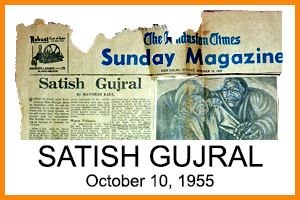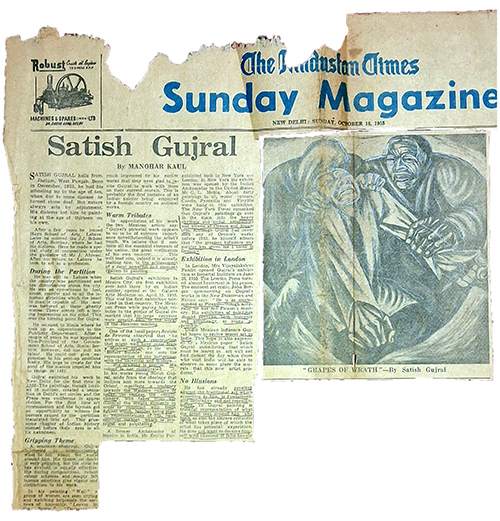

The Hindustan Times, Sunday, New Delhi: October 10, 1955
SATISH GUJRAL
By MANOHAR KAUL
The Hindustan Times
New Delhi: October 10, 1955
Satish Gujral hails from Jhelum, West Punjab. Born in December 1925, he had his schooling up to the age of ten, when due to some disease he turned stone deaf. But nature always acts by adjustment. His distress led him to painting at the age of thirteen. After a few years of working on his own, he joined the Mayo School of Arts, Lahore. Later, he entered the J. J. School of Arts, Bombay, where he had formal training and obtained his diploma. Here, he made a special study of composition under the guidance of Mr. J. Ahivasi. After his return to Lahore, he took to art as a profession. He was still in Lahore when the country was partitioned, and the disturbances shook the city. He was an eyewitness to loot, arson, murder, and to all the inhuman atrocities which the beast in man is capable of. These scenes left a lasting impression on his mind. This was the turning point for Gujral. He escaped to Simla where he took up an appointment in the Publicity Department. After a couple of years, he was appointed Vice Principal of the Government School of Arts, Simla. Service, however, did not suit his temperament. He could not give expression to his pent-up emotions freely. His urge to create for the good of the masses impelled him to resign in 1951. Gujral exhibited his work in New Delhi for the first time in 1952. The paintings, though limited in number, created a sensation in Delhi’s art circles. The restless, the revolutionary, the sincere criticism of what takes place around him, and the truthful representation of the life the artist sees around him—all struck a chord. The art connoisseurs and the layman got a strong reaction. The Press was vociferous in appreciation. In New York, his exhibition was opened by the Indian Ambassador in the United States, Mr. G. L. Mehta. About forty works were exhibited, both in oil, watercolour, casein, pyroxylin, and vinylite. The New York Times remarked that “the greatest influence any painter has given me, I think, is Gujral.” His paintings so often fell into the heavy rhythms and social symbolism of Orozco and Siqueiros, although Gujral had never seen Orozco’s work before 1952. He himself admitted that the greatest influence he received was from the murals of Diego Rivera and other Mexican masters. In London, Mrs. Vijayalakshmi Pandit opened Gujral's exhibition at the Imperial Institute on June 20, 1955. The London press turned almost hysterical in his praise. The eminent art critic, John Berger, commenting in the New Statesman and Nation, wrote: “He is as single-minded as Picasso, though naturally he has not Picasso's mastery.” The Mexican Press, while paying high tribute to Gujral’s genius, remarked that his large and powerful pictorial work could provoke, both humanly and artistically, as many emotions as Rivera’s or Siqueiros’s. One of the local papers, Revista de Revistas, observed that “he is probably the first Indian painter to receive such a constructive reception in Mexico.” His exhibition in Mexico City—the first ever held there by an Indian painter—opened at the Galeria Arte Moderno on April 15, 1955. This was also the first exhibition televised in that country. The Ambassador of Mexico in India, Mr. Emilio Portes Gil, paid warm tributes to Gujral’s work, remarking that it contained all the essential elements of his nation and the great civilization of his own country. The Mexican art world expressed hope that Satish Gujral would one day help revive mural art in India. Gujral’s pictorial work appears to be of extreme importance, notwithstanding the artist’s youth. It is already leading him to the achievement of a most powerful and eloquent gallery in painting. A sensitive observer, Gujral paints what he feels about the world around him. His theme, no doubt, is very gripping, but the style he has evolved is equally effective. In his painting Wail, a group of women are seen crying and watching helplessly the sorrows of humanity. Leaves in the Wind, Funeral Procession, and Grapes of Wrath (his most discussed painting), are all filled with powerful content. His daring compositions, robust colour schemes, and deeply felt human emotions give vigour and distinction to his work. Satish Gujral has already revolted against the traditional art which caters to external surface decoration. He does not want to deceive himself with illusions of false beauty. His realism, informed by personal experience, makes his expression authentic and relevant. In his work, young Satish Gujral, aside from the ideology that inclines him more towards the Orient, manifests an artistic purpose in which content and form are inextricably united.
